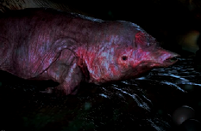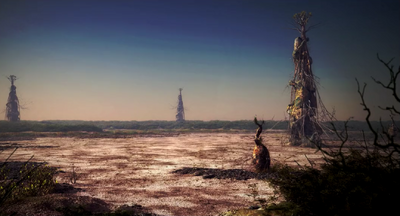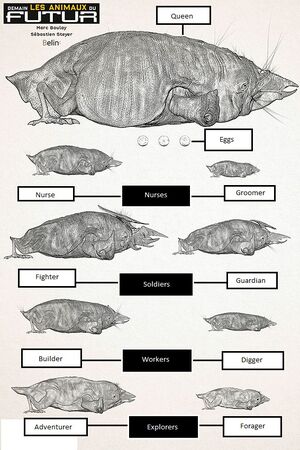
A nurse Talpidornis sechani.
Systematic: aves (bird), passeriform ("passerine"), Ploceidae (weaver bird).
Etymology: from "talpid", mole in Latin, and "ornis", bird. The species is dedicated to the French singer, songwriter and actor Renaud Séchan for his interest and assistance to the natural sciences.
Cousin of the 21st century: Dinemellia dinemelli, White-headed buffalo weaver.
Size: About 30 cm long for individuals "ordinary" of the colony. The queen can reach one meter.
Distribution: steppe and desert Eurafrica.

Talpidornis built impressive aerial buildings: the "talpiniary". They are made of a mixture of saliva and mud deposited around a plant carefully cultivated by the colony (Neophorbia). The height of the "talpinary" is an outward sign of power. However, the wars between clans raging, these buildings rarely amount to more than 10 meters above the ground.
Morphology: The burrowing weaver is blind. It looks like a single déplumé- chicken feathers around the beak act as tactile filaments. The body is large, the strong bill and narrowed neck. The wings have turned into picks.
Ecology and ethology: Like its cousin the 21st century, Talpidornis is a bird living in colonies. Its companies are however underground, matriacales and composed of specialized individuals: workers, nurses, soldiers and reproductive queen. A difference termites and other social insects, Talpidornis kept to a reproduction of sexual kind. Omnivorous, it builds profound and complex networks with several gallery rooms for storing eggs or food. Predators include Nosferapoda.
Interspecific diversity: gender Talpidornis account several species, among which T. minoguei, smaller than T. oundjiani and being found only in Australia.
A large family six feet underground

Castes in Talpidornis sechani
Often, underground and colonial species are organized into castes, each with a well-defined status.
Thus the queen, huge, spends most clear of its existence (over 25 years) to spawn. When not fertilized by males, she kept by nurses.
The latter are divided into two sub-castes in ants as: small (the groomers) take care of the queen while larger (nurses) deal eggs, they deposit in incubation rooms, real incubators at controlled temperature.
As soon as the male chicks are identified, they are trained to become soldiers. Most fighters have the right to fertilize the queen. The selection is made for the soldier showing off the finest headsets -the horny growths beak directed toward the back- and finest studs in the front.
The others are stuffed a juice secreted by the queen, making sexually inactive. They become workers ("builders" or "diggers") based on their morphology and the needs of the colony.
Finally, the explorers also form two sub-castes: large (adventurers) goes in search of new territory, far enough adventure of the main colony, while small (forager) reported food under the watchful eyes of soldiers .
